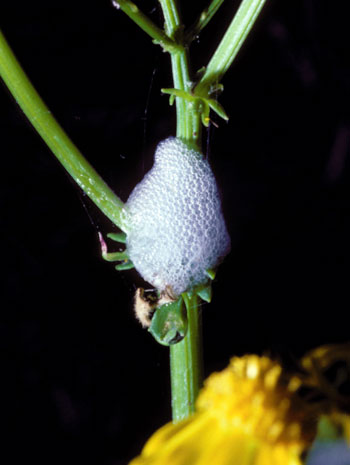Who drooled all over my plants?
Spittlebugs are likely the culprit of globs of bubbly froth found on trees, shrubs and plants during late spring.
 It’s that magic time of year where everyone is out pulling weeds and beautifying their landscapes. Many gardeners have been shocked to find globs of a bubbly froth on a variety of trees, shrubs and smaller plants. Michigan State University Extension horticulture educators and Master Gardener hotlines are often asked about where all the spit is coming from. It is a common late spring question every year.
It’s that magic time of year where everyone is out pulling weeds and beautifying their landscapes. Many gardeners have been shocked to find globs of a bubbly froth on a variety of trees, shrubs and smaller plants. Michigan State University Extension horticulture educators and Master Gardener hotlines are often asked about where all the spit is coming from. It is a common late spring question every year.
New gardeners are shocked. Smart gardeners are not, because they recognize this as the annual running of the spittlebugs. This small, true bug goes by several other common names. In some places of the country they are called frog hoppers or spit bugs. The frothy stuff goes by the quaint names of frog spit, cuckoo spit, snake spit and just plain spittle. The small insect responsible for this spit-fest is the nymph or immature spittlebug.
Mother spittlebug laid her eggs in the spring, often at a leaf axil. This is where the leaf and stem meet. When the kiddies hatch out, they quickly begin sucking in plant juices. Being a true bug, this is how they feed. Some of the plant juice or sap is food and the majority is turned into foamy bubbles that bury the nymph. All this attractive cover serves several purposes, all of which is beneficial to a lone nymph alone in this cruel world. The bubbles disguise the small insect’s location from predators. The froth regulates the temperature to protect the nymph from hot and cold weather shifts. The bubbles also act as a moisture regulator so the little guy does not dry out. Predators are not interested in pushing their way through the glop acidic foam for such a miniscule prize.
Control is often not necessary for spittlebugs. The size of the plant versus the number of bubble masses needs to be considered. If the plant is large and there are a few, control may not be necessary. If it is a small plant, a weak plant or one that was recently transplanted, control may be beneficial. All that is required is a hose and water. The spittlebug and its foamy home can be flooded off the plant. Wash off the bubbles with a stream of water that does not damage the plant. Check every day or so for several weeks and wash away all foam piles as they appear. The nymphs will only be around for a few weeks each late spring, so looking for them all season is not necessary.
There are also pine spittlebugs that may be numerous on some trees, so it is a good idea to inspect all pines now. With a large population, there could be browning and death of needles. This affects the look of the trees in your landscape.
All gardeners should check their gardens and yards for problems, but still be amazed that such a little bug could make so much conspicuous spit.



 Print
Print Email
Email



